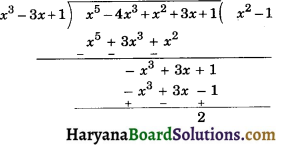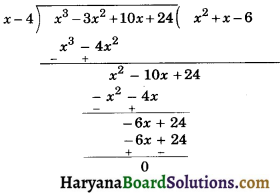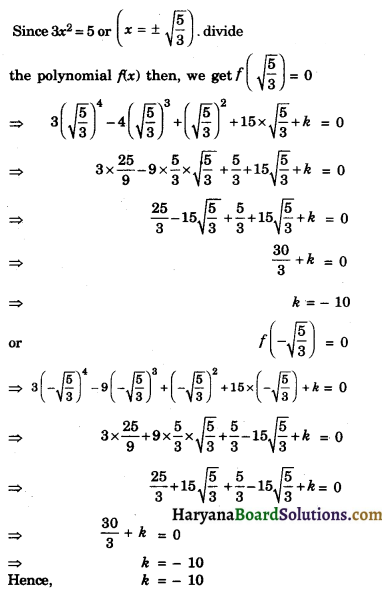Haryana State Board HBSE 10th Class Maths Important Questions Chapter 2 Polynomials Important Questions and Answers.
Haryana Board 10th Class Maths Important Questions Chapter 2 Polynomials
Short/Long Answer Type Questions
Question 1.
Find the zeroes of the quadrate polynomial x2 + x – 2, and verify the relationship between the zeroes and coefficients.
Solution :
Let f(x) = x2 + x – 2
= x2 + (2 – 1)x – 2
= x2 + 2x – x – 2
= x(x + 2) – 1(x + 2)
= (x + 2) (x – 1)
To find the zeroes of the polynomial f(x)
Put
f(x) = 0
⇒ (x + 2) (x – 1) = 0
⇒ x + 2 = 0
⇒ x = – 2 And
(x – 1) = 0
⇒ x = 1
Therefore, zeroes of the polynomial f(x) are :
α = – 2, β = 1
Now, sum of the zeroes = α + β = – 2 + 1 = – \(\frac {1}{1}\)
= – Coefficient of x / Coefficient of x2
And product of zeroes α × β = – 2 × 1 = – \(\frac {2}{1}\)
= Constant term / Coefficient of x2
∴ Zeroes of the polynomial f(x) are – 2, 1.
![]()
Question 2.
Find the zeroes of the quadratic polynomial 7y2 – \(\frac {11}{3}\)y – \(\frac {2}{3}\) and verify the relationship between the zeroes and the coefficients.
Solution :
Let p(x) = 7y2 – \(\frac {11}{3}\)y – \(\frac {2}{3}\)
= \(\frac {1}{3}\) (21y2 – 11y – 2)
= \(\frac {1}{3}\) [12y2 – (14 – 3)y – 2]
= \(\frac {1}{3}\) [12y2 – 14y + 3y – 2]
= \(\frac {1}{3}\) [7y (3y – 2) + 1 (3y – 2)]
= \(\frac {1}{3}\) (3y – 2) (7y + 1)
To find the zeroes of the polynomial p(x).
Put
p(x) = 0
⇒ \(\frac {1}{3}\) (3y – 2)(7y + 1) = 0
⇒ (3y – 2)(7y + 1) = 0
⇒ 3y – 2 = 0 and 7y + 1 = 0
⇒ y = \(\frac {2}{3}\) and y = – \(\frac {1}{7}\)
Therefore, zeroes of the polynomial P(x) are:
α = \(\frac {2}{3}\) and β = – \(\frac {1}{7}\)
Now, sum of the zeroes = α + β = \(\frac{2}{3}-\frac{1}{7}\)
= \(\frac{14-3}{21}=\frac{11}{21}=\frac{11}{7 \times 3}=\frac{\frac{11}{3}}{7}\)
= – Coefficient of x / Coefficient of x2
And product of zeroes = α × β = \(\frac{2}{3} \times \frac{-1}{7}=\frac{-\frac{2}{3}}{7}\)
= Constant term / Coefficient of x2
Hence, zeroes of p(x) = \(\frac{2}{3}, \frac{-1}{7}\)
Question 3.
Find the zeroes of a quadratic polynomial x2 – 2x – 15 and verify the relationship between the zeroes and coefficient of this polynomial.
Solution :
Let p(x) = x2 – 2x – 15
= x2 – (5 – 3)x – 15
= x2 – 5x + 3x – 15
= x(x – 5) + 3(x – 5)
= (x – 5) (x + 3)
To find the zeroes of polynomial p(x),
Put
p(x) = 0
⇒ (x – 5) (x + 3) = 0
⇒ x – 5 = 0 and x + 3 = 0
⇒ x = 5 and x = – 3
Therefore, zeroes of the polynomial p(x) are :
α = 5 and β = – 3
Sum of zeroes = α + β = 5 + (-3)
= 2 = \(\frac {2}{1}\) = \(\frac{-(-2)}{1}\)
= – Coefficient of x / Coefficient of x2
And product of zeroes = α + β = 5 × (-3) = \(\frac {-15}{1}\)
= Constant term / Coefficient of x2
Hence, zeroes of the p(x) = 5, – 3.
![]()
Question 4.
Find the value of k such that the polynomial x2 – (k + 6)x + 2(2k – 1) has sum of its zeroes equal to half to their product.
Solution :
Let
p(x) = x2 – (k + 6)x + 2(2k – 1) and let α and β be zeroes of p(x)
Then sum of zeroes = α + β = – \(\frac{-(k+6)}{1}\)
= + (k + 6)
And product of zeroes = α × β = \(\frac{2(2 k-1)}{1}\)
= 2(2k – 1)
According to question
Sum of zeroes of p(x) = \(\frac {1}{2}\)Product of zeroes of it
⇒ (k + 6) = \(\frac {1}{2}\) × 2 (2k – 1)
⇒ k + 6 = 2k – 1
⇒ 6 + 1 = 2k – k
⇒ k = 7
Question 5.
Find the quadratic polynomial whose sum and product of zeroes are and respectvely.
Solution :
Sum of zeroes = α + β = \(\frac {21}{8}\)
And product of zeroes = α × β = \(\frac {5}{16}\)
So, the required quadratic polynomial is :
= x2 – (α + β)x + αβ
= x2 – \(\frac {21}{8}\)x + \(\frac {5}{16}\)
= \(\frac {1}{16}\) (16x2 – 42x + 5)
![]()
Question 6.
Find a quadratic polynomial whose zeroes are reciprocal of the zeroes of the polynomial f(x) = ax2 + bx + c, a ≠ 0, c ≠ 0.
Solution :
f(x) = ax2 + bx + c (given)
Let α and β be the zeroes of f(x)
Then,
α + β = – \(\frac {b}{a}\) And αβ = \(\frac {c}{a}\)
Since, zeroes of required polynomial are reciprocal of zeroes of polynomial f(x).
Therefore zeroes of required polynomial are \(\frac {1}{α}\) and \(\frac {1}{β}\)
∴ Sum of zeroes = \(\frac{1}{a}+\frac{1}{\beta}=\frac{\alpha+\beta}{\alpha \beta}=\frac{-\frac{b}{a}}{\frac{c}{a}}\)
= \(\frac{-b}{a} \times \frac{a}{c}=\frac{-b}{c}\)
And product of zeroes = \(\frac{1}{\alpha} \times \frac{1}{\beta}=\frac{1}{\alpha \beta}=\frac{1}{\frac{c}{a}}\)
= \(\frac {a}{c}\)
Required polynomial = x2 – (sum of zeroes)x + product of zeroes
= x2 + – (- \(\frac {b}{c}\))x + \(\frac {a}{c}\)
= x2 + \(\frac{b x}{c}+\frac{a}{c}=\frac{1}{c}\)(cx2 + bx + a)
Question 7.
If α and β are zeroes of a polynomial x2 – 4\(\sqrt{3}\)x + 3, then find the value of α + β – αβ.
Solution :
Let p(x) = x2 – 4\(\sqrt{3}\)x + 3
Since, α and β are zeroes of p(x), then α + β = sum of zeroes = \(\frac{-(-4 \sqrt{3})}{1}\) = 4\(\sqrt{3}\)
And α × β = product zeroes = \(\frac {3}{1}\) = 3
Now, α + β – αβ = 4\(\sqrt{3}\) – 3.
![]()
Question 8.
Divide x3 – 6x2 + 11x – 6 by x – 2 and verify the division algorithm.
Solution :
Let f(x) = x3 – 6x2 + 11x – 6 and g(x) = x – 2
Now, we divide f(x) by g(x), as follows

Hence, q(x) = x2 – 4x + 3 and r(x) = 0.
According to division algorithm of polynomials.
f(x) = g(x) × q(x) + r(x)
⇒ x3 – 6x2 + 11x – 6 = (x – 2) (x2 – 4x + 3) + 0
⇒ x3 – 6x2 + 11x – 6 = x3 – 4x2 + 3x – 2x2 + 8x – 6
⇒ x3 – 6x2 + 11x – 6 = x3 – 6x2 + 11x – 6
∴ LHS = RHS
Hence, the division algorithm is verified.
Question 9.
Verify g(x) = x3 – 3x + 1 is a factor of P(x) = x5 – 4x3 + x2 + 3x + 1 or not.
Solution :
If g(x) = x3 – 3x + 1 is a factor of p(x) = x5 – 4x3 + x2 + 3x + 1, then p(x) is divisible by g(x) completely i.e., obtained remainder is zero.
Now we divide p(x) by g(x) as follows

Since, obtained remainder is not zero. So, g(x) is not a factor of p(x).
![]()
Question 10.
If 4 is zero of the cubic polynomial x3 – 3x2 – 10x + 24, find its other two zeroes.
Solution :
Let f(x) = x3 – 3x2 – 10x + 24
We know that if a is a zero of f(x) then (x – α) is a factor of f(x)
Since 4 is zero of f(x) then (x – 4) is a factor of f(x)
Now, we divide f(x) by (x – 4) as follows

According to division algorithm of polynomials
x3 – 3x2 – 10x + 24 = (x – 4) (x2 + x – 6)
= (x – 4) [x2 + (3 – 2)x – 6]
= (x-4) [x2 + 3x – 2x – 6]
= (x – 4) [x(x +3) – 2(x + 3)]
= (x – 4) (x + 3) (x – 2)
For zeroes of the polynomial f(x) = 0
∴ (x – 4)(x + 3)(x – 2) = 0
⇒ x = 4, x = – 3, x = 2
Hence, other two zeroes of the polynomial are : – 3, 2
Question 11.
Find all zeroes of the polynomial 2x4 + – 9x3 + 5x2 + 3x – 1, if two of its zeroes are (2 + \(\sqrt{3}\)) and (2 – \(\sqrt{3}\)).
Solution :
Since, (2 + \(\sqrt{3}\)) and (2 – \(\sqrt{3}\)) i.e., (2 ± \(\sqrt{3}\)) are zeroes of polynomial 2x4 – 9x3 + 5x2 + 3x – 1 then (x – 2 – \(\sqrt{3}\))(x – 2 + \(\sqrt{3}\)) or (x – 2)2 – (\(\sqrt{3}\))2 or x2 – 4x + 1 is a factor of f(x).
Now, we divide f(x) by x2 – 4x + 1 as follows

According to division algorithm of polynomials
2x4 – 9x3 + 5x2 + 3x – 1
= (x2 – 4x + 1)(2x2 – x – 1) + 0
= [(x – 2)2 – (\(\sqrt{3}\))2][(2x2 – 2x + x – 1]
= (x – 2 – \(\sqrt{3}\))(x – 2 + \(\sqrt{3}\)) [2x (x – 1) + 1(x – 1)]
= (x – 2 – \(\sqrt{3}\))(x – 2 + \(\sqrt{3}\))(x – 1) (2x + 1)
For the zeroes of the polynomial f(x) = 0
(x – 2 – \(\sqrt{3}\))(x – 2 + \(\sqrt{3}\))(x – 1) (2x + 1) = 0
⇒ x = 2 + \(\sqrt{3}\), 2 – \(\sqrt{3}\), 1, – \(\frac {1}{2}\)
Hence, all zeroes of polynomial are:
2 + \(\sqrt{3}\), 2 – \(\sqrt{3}\), 1, –\(\frac {1}{2}\)
![]()
Question 12.
For what value of k, is the polynomial f(x) = 3x4 – 9x3 + x2 + 15x + k completely divisible by 3x2 = 5,
Solution :

Fill in the Blanks
Question 1.
The zeroes of a polynomial p(x) are the…………of the points, where the graph of y = p(x) intersects the x-axis.
Solution :
x-coordinates
Question 2.
A cubic polynomial has at most ………….. zeroes.
Solution :
three
![]()
Question 3.
If α and β are the zeroes of the quadratic polynomial ax2 + bx + c = 0, a ≠ 0 . then:
α + β = …………..
αβ = ……………
Solution :
\(\frac{-b}{a}, \frac{c}{a}\)
Question 4.
If α, β and γ are the zeroes of the cubic polynomial ax2 + bx2 + cx + d = 0, a ≠ 0, then:
αβ + βγ + γα = ………….
αβγ = ………….
Solution :
\(\frac{c}{a}, \frac{-d}{a}\)
Question 5.
A ………….. polynomial has atmost two zeroes.
Solution :
quadratic
![]()
Question 6.
A linear polynomial has only ……… zero.
Solution :
one.
Multiple Choice Questions
Question 1.
If one zero of the quadratic polynomial x2 + 3x + k is 2, then value of k is :
(a) 10
(b) – 10
(c) – 7
(d) – 2
Solution :
(b) – 10
Let p(x) = x2 + 3x + k and let other zero be β, then
α + β = – \(\frac {b}{a}\)
⇒ 2 + β = \(\frac {- 3}{1}\)
⇒ β = – 3 – 2 = – 5
And α × β = \(\frac {c}{a}\)
⇒ 2 – 5 = \(\frac {k}{1}\)
⇒ – 10 = k
Question 2.
The quadratic polynomial, the sum of whose zeroes is – 5 and their product is 6, is :
(a) x2 + 5x + 6
(b) x2 – 5x + 6
(c) x2 – 5x – 6
(d) – x2 + 5x + 6
Solution :
(a) x2 + 5x + 6
∵ Sum of zeroes = (α + β) = – 5
And product of zeroes = α × β = 6
So, the required quadratic polynomial is
f(x) = x2 – (α + β)x + αβ
= x2 – (-5)x + 6
= x2 + 5x + 6.
![]()
Question 3.
The zeroes of the polynomial x2 – 3x – m (m + 3) are :
(a) m, (m + 3)
(b) – m, (m + 3)
(c) m, – (m + 3)
(d) – m, – (m + 3)
Solution :
(b) – m, (m + 3)
∵ Let f(x) = x2 – 3x – m (m + 3)
Putting x = – m, we get
⇒ f(x) = (m)2 – 3 × – m – m (m + 3)
= m2 + 3m – m2 – 3m = 0
And putting
x = (m + 3), we get
f(x) = (m + 3)2 – 3(m + 3) – m (m + 3)
= (m + 3) [m + 3 – 3 – m]
= (m + 3) (0) = 0.
Hence, – m and (m + 3) are zeroes of the given polynomial
Question 4.
If 2 is factor of polynomial f(x) = x4 – x3 – 4x2 + kx + 10
(a) 2
(b) – 2
(c) – 1
(d) 1
Solution :
(c) – 1
f(2) = 24 – 23 – 4 × 22 + k × 2 + 10
⇒ 0 = 16 – 8 – 16 + 2k + 10
⇒ 0 = 2k + 2
⇒ 2k = -2
∴ k = – 1
Hence option (c) is correct.
![]()
Question 5.
Find that polynomial whose zeros are – 5 and 4 :
(a) x2 – x – 20
(b) x2 + x – 20
(c) x2 – x + 20
(d) x2 + x + 20
Solution :
(b) x2 + x – 20
Let β
α = – 5 and β = 4
Then
α + β – 5 + 4 = 1 and
αβ = – 5 × 4 = – 20
Quadratic polynomial x2 – (α + β)x + αβ = 0
x2 – (-1)x + (-20) = 0
x2 + x – 20 = 0
Hence, option (b) is correct.
Question 6.
Expression (x – 3) will be a factor of polynomial f(x) = x3 + x2 – 17x + 15 if:
(a) f(3) = 0
(b) f(-3) = 0
(c) f(2) = 0
(d) f(- 2) = 0
Solution :
(a) f(3) = 0
f(x) = x3 + x2 – 17x + 15
f(3) = (3)3 + (3)2 – 17 (3) + 15
= 27 + 9 – 51 + 15 = 0
f(3) = 0
Hence, option (a) is correct.